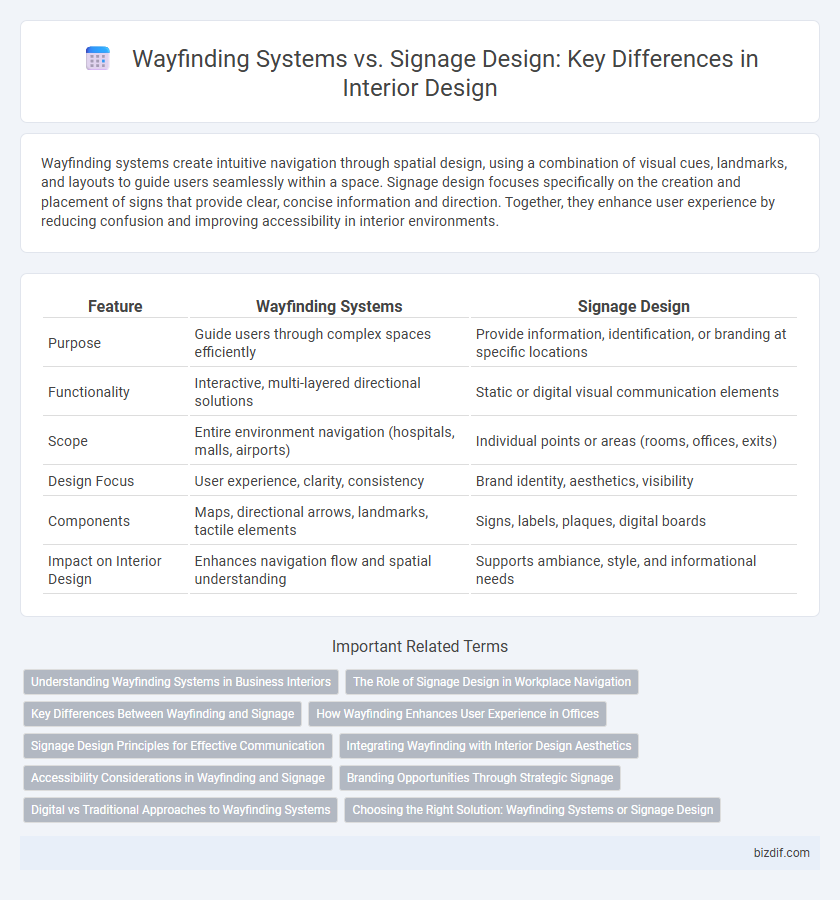Wayfinding systems create intuitive navigation through spatial design, using a combination of visual cues, landmarks, and layouts to guide users seamlessly within a space. Signage design focuses specifically on the creation and placement of signs that provide clear, concise information and direction. Together, they enhance user experience by reducing confusion and improving accessibility in interior environments.
Table of Comparison
| Feature | Wayfinding Systems | Signage Design |
|---|---|---|
| Purpose | Guide users through complex spaces efficiently | Provide information, identification, or branding at specific locations |
| Functionality | Interactive, multi-layered directional solutions | Static or digital visual communication elements |
| Scope | Entire environment navigation (hospitals, malls, airports) | Individual points or areas (rooms, offices, exits) |
| Design Focus | User experience, clarity, consistency | Brand identity, aesthetics, visibility |
| Components | Maps, directional arrows, landmarks, tactile elements | Signs, labels, plaques, digital boards |
| Impact on Interior Design | Enhances navigation flow and spatial understanding | Supports ambiance, style, and informational needs |
Understanding Wayfinding Systems in Business Interiors
Wayfinding systems in business interiors integrate spatial design, graphic elements, and technology to enhance navigation and user experience within complex environments. Unlike traditional signage design that primarily conveys information, wayfinding systems prioritize intuitive movement by incorporating landmarks, directional cues, and visual hierarchy tailored to the architectural layout. Effective wayfinding reduces confusion, improves operational efficiency, and fosters a positive impression for clients and employees in corporate, healthcare, and retail spaces.
The Role of Signage Design in Workplace Navigation
Signage design plays a critical role in workplace navigation by creating clear visual cues that guide employees and visitors efficiently through complex office layouts. Effective signage systems enhance spatial understanding, reduce confusion, and improve overall workflow by integrating consistent typography, colors, and symbols tailored to the corporate environment. Unlike broader wayfinding systems that encompass multiple navigational tools, signage design specifically focuses on the strategic placement and visual clarity of signs to facilitate immediate and intuitive wayfinding.
Key Differences Between Wayfinding and Signage
Wayfinding systems encompass comprehensive strategies that guide users through spaces using a combination of directional cues, maps, and environmental design, whereas signage design primarily focuses on creating individual signs that convey information or instructions. Wayfinding integrates multiple elements such as landmarks, pathways, and digital interfaces to facilitate navigation, contrasting with signage's narrower role of providing specific visual messages. The key difference lies in wayfinding's holistic approach to spatial orientation versus signage's function as discrete communication tools.
How Wayfinding Enhances User Experience in Offices
Wayfinding systems enhance user experience in offices by providing clear, intuitive navigation that reduces stress and saves time, promoting productivity. Unlike traditional signage design that primarily focuses on static information display, wayfinding integrates spatial cues, digital interfaces, and environmental graphics to create seamless movement through complex office layouts. Effective wayfinding improves accessibility and employee satisfaction by facilitating easy access to meeting rooms, workstations, and amenities.
Signage Design Principles for Effective Communication
Signage design principles for effective communication prioritize clarity, legibility, and consistency to guide users intuitively through spaces. Using contrasting colors, universal icons, and concise wording enhances visibility and quick comprehension, critical in environments like airports and hospitals. Proper placement at eye level and incorporation of brand identity ensure signage not only informs but also reinforces the spatial experience.
Integrating Wayfinding with Interior Design Aesthetics
Integrating wayfinding systems with interior design aesthetics enhances spatial navigation while maintaining visual harmony within a space. Effective wayfinding leverages design elements such as color palettes, materials, and typography consistent with the interior style to create intuitive and seamless directional cues. Balancing functionality and design ensures that signage complements the environment, improving user experience without disrupting the overall aesthetic flow.
Accessibility Considerations in Wayfinding and Signage
Wayfinding systems and signage design play critical roles in enhancing accessibility by providing clear, intuitive navigation cues for all users, including those with visual, cognitive, or mobility impairments. Effective wayfinding incorporates tactile elements such as braille, high-contrast visuals, and universally recognized icons to accommodate diverse accessibility needs. Signage design must comply with ADA standards, ensuring placements are reachable and readable, thereby promoting independence and inclusivity in interior environments.
Branding Opportunities Through Strategic Signage
Wayfinding systems and signage design both play crucial roles in guiding users through spaces, but strategic signage offers unique branding opportunities by integrating visual identity elements such as logos, color schemes, and typography to create a cohesive brand experience. Effective wayfinding leverages branded signage to enhance user orientation while reinforcing brand recognition and loyalty within commercial, public, and hospitality interiors. Incorporating brand storytelling into signage design strengthens emotional connections and ensures consistency across all touchpoints in the built environment.
Digital vs Traditional Approaches to Wayfinding Systems
Digital wayfinding systems integrate interactive directories, real-time updates, and touchscreens, offering dynamic navigation tools that enhance user engagement and accessibility in complex spaces such as airports and hospitals. Traditional signage design relies on static printed materials, like plaques and directional arrows, providing clear, consistent visual cues without technological dependence. The choice between digital and traditional approaches depends on factors like budget, user demographics, and the complexity of the environment, with hybrid systems increasingly common to maximize effectiveness.
Choosing the Right Solution: Wayfinding Systems or Signage Design
Wayfinding systems integrate spatial planning, environmental cues, and intuitive graphics to guide users seamlessly through complex spaces, enhancing overall navigation efficiency. Signage design focuses on creating clear, visually impactful signs that convey specific information quickly and effectively, often used for identification and regulatory purposes. Choosing the right solution depends on the scale and function of the environment, with wayfinding systems suited for large, intricate buildings and signage design ideal for targeted communication in smaller or less complex areas.
Wayfinding systems vs Signage design Infographic

 bizdif.com
bizdif.com